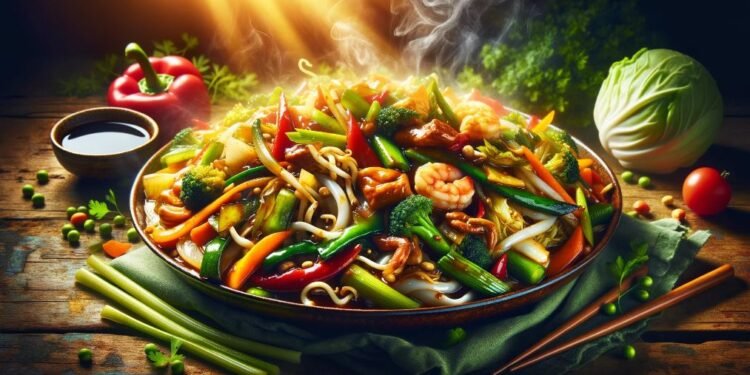Last Updated on November 3, 2023 by admin
Introduction
Chop Suey, a popular dish in American Chinese cuisine, is a vibrant medley of meats, vegetables, and sauces cooked to perfection and served over a bed of rice or noodles. This dish, with its origins deeply rooted in the history of Chinese immigrants in the United States, is a testament to the blending of cultures and flavors that define American cuisine. In this article, we will embark on a culinary journey, exploring the rich history, key ingredients, and cultural significance of Chop Suey.
History of Chop Suey
The origins of Chop Suey are as varied and diverse as the dish itself. Some say a Chinese chef in California invented it during the Gold Rush, while others believe Chinese immigrants in New York City created it. Despite its unclear beginnings, one thing is sure – Chop Suey is a product of Chinese immigrants adapting their traditional cuisine to the ingredients available in America. Over the years, the dish has evolved, incorporating regional flavors and components and becoming a staple in Chinese American cuisine.
There are several theories regarding the origin of chop suey. One popular myth is that a Chinese chef in California created it during the Gold Rush, who threw together whatever ingredients he had to make a delicious and filling dish. Others believe that chop suey was invented by Chinese immigrants in New York City, who adapted their traditional recipes to suit the tastes of American diners. Regardless of its origins, chop suey has become a beloved part of American cuisine, and its popularity shows no signs of waning.
Ingredients and Preparation
A traditional chop suey dish consists of various vegetables such as bean sprouts, cabbage, and celery, along with a protein source such as chicken, beef, or shrimp. The ingredients are stir-fried together in a savory sauce made from soy sauce, oyster sauce, and other seasonings. The result is a delicious and hearty meal that is both flavorful and satisfying.
When it comes to preparing chop suey, the possibilities are endless. The key to an excellent chop suey dish is using fresh, high-quality ingredients and cooking techniques. Start by marinating your protein in soy sauce, garlic, and ginger to infuse it with flavor. Next, stir-fry the vegetables until they are tender but still crisp, then add the protein and sauce. Cook everything together until the flavors meld and the sauce thickens, then serve over rice or noodles for a delicious and satisfying meal.
Cultural Significance
Chop Suey holds a special place in the hearts of Chinese Americans, serving as a symbol of their heritage and the fusion of cultures that defines their identity. The dish is a testament to the adaptability and resilience of Chinese immigrants, who took the flavors and ingredients of their homeland and transformed them into something uniquely American. Today, chop suey is enjoyed by people of all backgrounds, and it continues to be a beloved staple in Chinese American cuisine.
In addition to its delicious taste, chop suey is also a reflection of the Chinese-American experience. The dish is a testament to the adaptability and resilience of Chinese immigrants, who took the flavors and ingredients of their homeland and transformed them into something uniquely American. Today, chop suey is enjoyed by people of all backgrounds, and it continues to be a beloved staple in Chinese American cuisine.
Conclusion
In conclusion, Chop Suey is a dish that is rich in history, full of flavor, and deeply rooted in the Chinese American experience. From its origins as a simple, improvised meal created by Chinese immigrants to its evolution into a beloved staple in Chinese American cuisine, Chop Suey is a testament to the fusion of cultures and flavors that defines American cuisine. Whether you are a fan of traditional Chinese food or enjoy trying new and exciting dishes, Chop Suey will satisfy your taste buds and leave you craving more. So, the next time you are in the mood for something delicious and hearty, why not give Chop Suey a try? You won’t be disappointed!
Also, Read The Essential Guide to Aquatic Vegetation Management.









